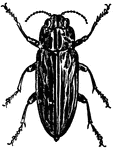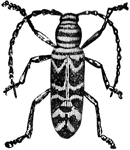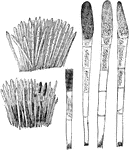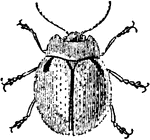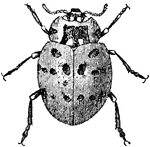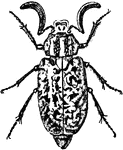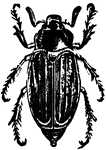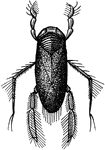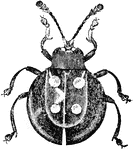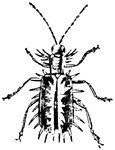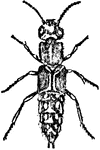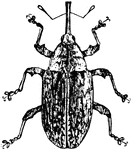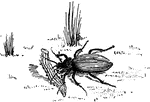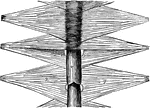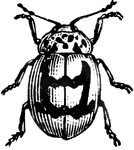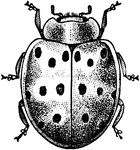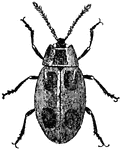
Tiger Beetle
The tiger beetles are a large group of beetles known for their predatory habits. Some tiger beetles…

Typograhic Beetle
"The typographic beetle recieves it's name... from the circumstance that the burrows formed by it in…
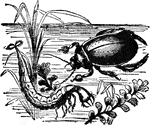
Water Beetle
"Water Beetles are beetles which live on or in the water. The Dytiscus, common in stagnant water, is…
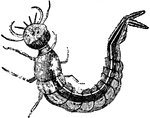
Water Beetle Larva
Water beetles carry air bubbles under their abdomens, which provides an air supply. Water beetle larvae…

Wood Tiger Beetle
A group of beetles known for being preditors. They have bulging eyes and slender legs.

Woodboring Beetle
The term woodboring beetle encompasses many species and families of beetles whose larval or adult forms…

Burying Beetles, Burying a Dead Bird
Also called Sexton Beetles, these beetles bury the carcasses of small vertebrates as food for their…
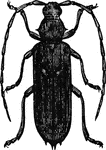
Banded Hickory Borer
Very variable in size and color, but usually a brownish gray and covered in shory whitish gray hairs.…
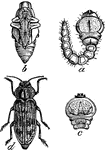
Flat Headed Apple Tree Borer
A long, depressed form borer. Usually brownish green, roughened by shallow pits of brighter metallic…

Brachelytra
"Readily distinguished from the other groups of beetles by having the elytra much shorter then the abdomen,…
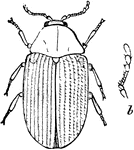
Brown Beetle
"Figure 11- Sitodrepa panicea enlarged. a, imago; b, its antenna, more enlarged" Elliot Coues, 1884
Bruchus Pisi
Pictured are the beetle of the natural size (a), and enlarged (b), and a pea (c) in which the hole of…

Giant Buprestis
"The Giant Buprestis, B. gigantea of guiana, is two inches long, and its body is of a green…
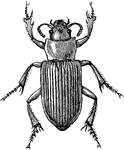
Caraboid Beetle
"Geopinus incrassatus. GEOPINUS. A genus of caraboid beetles, of the subfamily Harpalinae, having the…
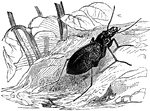
Blue Carabus
"The Blue Carabus, C. cyaneus, is an inch and a quarter long, the body oval, flat, and above…
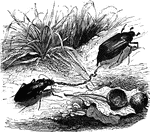
Golden Carabus and Cock-Chafer
"In illustration of the savageness of this race, the author of the "Jardin des Plantes" tells us of…
!["The Inquisitor Carabus, <em>C. inquisitor</em>, has the same form and manner as the [Sycophant Carabus]: the body is an inch long, and of a blackish-green color." — Goodrich, 1859](https://etc.usf.edu/clipart/14600/14649/inquiscarabs_14649_mth.gif)
Inquisitor Carabus
"The Inquisitor Carabus, C. inquisitor, has the same form and manner as the [Sycophant Carabus]:…

Cassida gibbosa
"The Cassida gibbosa of Brazil, three quarters of an inch long, is one of the larger species…
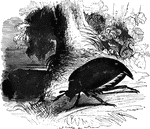
Cockchafer
"In the common European Cock-Chafer, Melolontha vulgaris, they are of considerable length,…

Male and Female Cockchafer
Cockchafer, also known as may bugs, is the common name of melolontha vulgaris. These beetles are native…

Larva of the Colorado Beetle
The larva of the colorado beetle is very unlike the adult insect. The larva is harmful to gardens.
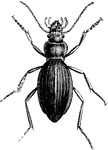
Common Ground Beetle
The common ground beetle feeds mostly on insects, though some of them are partly vegetarian.
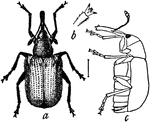
Rose Curculio
"Rose-curculio (Rhynchites bicolor). a, beetle; c, same in profile; b, claw." -Whitney, 1911

Devil's Coach Horse
The Devil's Coach Horse is also known as Rove Beetles. These beetles feed largely on decaying matter.

Fire-fly
Illustration of a fire-fly commonly found in the West Indies. Its scientific name is Pyrophorus noctilucus.

Common Eastern Firefly
"Common Firefly (Photinus pyralis). a, larva; b, pupa in its earthen cell; c, beetle. d, e, f, leg,…

Common Glowworm
The Common Glowworm (Lampyris noctiluca) is a species of beetle in the Lampyridae family of fireflies.
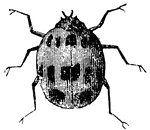
Ladybug
Ladybugs, or lady-birds look like little colored and spotted turtles. The larvae of these beetles prey…
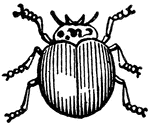
Ladybug
"Lady-bird beetles, or "lady bugs." These beetles are very destructive to plant lice." — Goff,…
